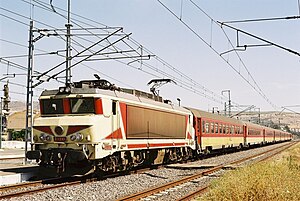ONCF E 1300
| E 1300 | |
|---|---|
|
E 1301 in Sidi-Kacem
|
|
| Numbering: | 1301-1318 |
| Number: | 18th |
| Manufacturer: | GEC Alsthom |
| Year of construction (s): | until 1992 |
| Axis formula : | B'B ' |
| Gauge : | 1435 mm ( standard gauge ) |
| Length over coupling: | 17.43 m |
| Service mass: | 84 t |
| Top speed: | 160 km / h |
| Continuous output : | 4000 kW |
| Starting tractive effort: | 275 kN |
| Power system : | 3 kV direct current |
| Power transmission: | Overhead line; 2 pantographs |
| Number of traction motors: | 2 |
| Drive: | electric |
The E 1300 is a series of electric locomotives produced by the Moroccan railway company Office National des Chemins de Fer (ONCF).
History, description and use
The eighteen class E 1300 express train locomotives were intended to replace the last vehicles delivered before the ONCF was founded. They were ordered from the French company GEC Alsthom ; they are closely related to the BB 7200 series of the French state railway SNCF . The locomotive boxes were made by the Société cherifienne de construction industrial et ferroviaire (SCIF) in Aïn Sebaâ , Morocco , where the machines were fully assembled. In each case a drive motor with GTO - chopper control drives both axes of the two bogies on. The design of the locomotives, known as “ Nez cassés ” (broken noses), comes from Paul Arzens .
As universal locomotives, the E 1300 are mainly used in fast passenger traffic. Since they do not have a 380 volt three-phase power supply for the cars, a generator car is added to the train for this purpose . The locomotives can also be found in front of freight trains, but rarely in the phosphate traffic, which makes up around 75% of the ONCF's freight volume.
Web links
- E 1300 at le-rail.ch
literature
- Howard Johnston, Ken Harris: Jane's Train Recognition Guide . HarperCollins Publishers, London 2005, ISBN 0-06-081895-6 .
